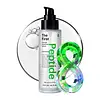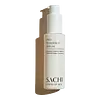What's inside
What's inside
 Key Ingredients
Key Ingredients

 Benefits
Benefits

 Ingredients Side-by-side
Ingredients Side-by-side

Water
Skin ConditioningButylene Glycol
HumectantGlycerin
HumectantDipropylene Glycol
Humectant1,2-Hexanediol
Skin ConditioningBetaine
HumectantNiacinamide
SmoothingMethylpropanediol
SolventPanthenol
Skin ConditioningSodium Hyaluronate
HumectantCentella Asiatica Leaf Extract
Skin ConditioningHyaluronic Acid
HumectantHydrolyzed Hyaluronic Acid
HumectantOryza Sativa Bran Extract
Skin ConditioningPhaseolus Radiatus Seed Extract
Skin ConditioningGlyceryl Polymethacrylate
Hydroxyethyl Urea
HumectantPolyglyceryl-10 Laurate
Skin ConditioningAllantoin
Skin ConditioningTromethamine
BufferingEthylhexylglycerin
Skin ConditioningDipotassium Glycyrrhizate
HumectantAdenosine
Skin ConditioningPolyglutamic Acid
Skin ConditioningSodium Phytate
Madecassoside
AntioxidantDipeptide Diaminobutyroyl Benzylamide Diacetate
Skin ConditioningBeta-Glucan
Skin ConditioningAsiaticoside
AntioxidantGlycine
BufferingSerine
MaskingGlutamic Acid
HumectantAspartic Acid
MaskingLeucine
Skin ConditioningAcetyl Hexapeptide-8
HumectantCopper Tripeptide-1
Skin ConditioningPalmitoyl Pentapeptide-4
Skin ConditioningAlanine
MaskingLysine
Skin ConditioningArginine
MaskingTyrosine
MaskingPhenylalanine
MaskingProline
Skin ConditioningThreonine
Valine
MaskingIsoleucine
Skin ConditioningTocopherol
AntioxidantHistidine
HumectantCysteine
AntioxidantMethionine
Skin ConditioningAcetyl Tetrapeptide-5
HumectantPalmitoyl Tetrapeptide-7
Skin ConditioningPalmitoyl Tripeptide-1
Skin ConditioningDextran
Palmitoyl Tripeptide-8
Skin ConditioningSqualane
EmollientPolyglyceryl-10 Stearate
Skin ConditioningCarbomer
Emulsion StabilisingWater, Butylene Glycol, Glycerin, Dipropylene Glycol, 1,2-Hexanediol, Betaine, Niacinamide, Methylpropanediol, Panthenol, Sodium Hyaluronate, Centella Asiatica Leaf Extract, Hyaluronic Acid, Hydrolyzed Hyaluronic Acid, Oryza Sativa Bran Extract, Phaseolus Radiatus Seed Extract, Glyceryl Polymethacrylate, Hydroxyethyl Urea, Polyglyceryl-10 Laurate, Allantoin, Tromethamine, Ethylhexylglycerin, Dipotassium Glycyrrhizate, Adenosine, Polyglutamic Acid, Sodium Phytate, Madecassoside, Dipeptide Diaminobutyroyl Benzylamide Diacetate, Beta-Glucan, Asiaticoside, Glycine, Serine, Glutamic Acid, Aspartic Acid, Leucine, Acetyl Hexapeptide-8, Copper Tripeptide-1, Palmitoyl Pentapeptide-4, Alanine, Lysine, Arginine, Tyrosine, Phenylalanine, Proline, Threonine, Valine, Isoleucine, Tocopherol, Histidine, Cysteine, Methionine, Acetyl Tetrapeptide-5, Palmitoyl Tetrapeptide-7, Palmitoyl Tripeptide-1, Dextran, Palmitoyl Tripeptide-8, Squalane, Polyglyceryl-10 Stearate, Carbomer
Water
Skin ConditioningGlycerin
HumectantPanthenol
Skin ConditioningPropanediol
SolventPentylene Glycol
Skin ConditioningSodium Carboxymethyl Betaglucan
Polygonum Aviculare Extract
EmollientRosmarinyl Glucoside
AntioxidantCaffeyl Glucoside
AntioxidantGallyl Glucoside
AntioxidantPalmitoyl Hexapeptide-52
Skin ConditioningPalmitoyl Hexapeptide-19
Skin ConditioningSodium Hyaluronate
HumectantTamarindus Indica Seed Extract
EmollientCeramide NP
Skin ConditioningCeramide AP
Skin ConditioningPhytosphingosine
Skin ConditioningCeramide EOP
Skin ConditioningArnica Montana Flower Extract
MaskingCurcuma Longa Root Extract
MaskingSilybum Marianum Seed Extract
Skin ConditioningThymus Vulgaris Leaf Extract
Skin ProtectingAloe Barbadensis Leaf Juice Powder
Skin ConditioningSodium Anisate
AntimicrobialCentella Asiatica Extract
CleansingCitric Acid
BufferingGlycyrrhiza Glabra Root Extract
BleachingCucumis Sativus Fruit Extract
EmollientSodium Lauroyl Lactylate
EmulsifyingSodium Benzoate
MaskingLeuconostoc/Radish Root Ferment Filtrate
AntimicrobialButylene Glycol
HumectantPhenoxyethanol
PreservativeSodium Levulinate
Skin ConditioningXanthan Gum
EmulsifyingPotassium Sorbate
PreservativeAphanothece Sacrum Polysaccharide
AbsorbentCholesterol
EmollientCarbomer
Emulsion StabilisingEthylhexylglycerin
Skin ConditioningPolyvinyl Alcohol
Lactic Acid/Glycolic Acid Copolymer
Skin ConditioningWater, Glycerin, Panthenol, Propanediol, Pentylene Glycol, Sodium Carboxymethyl Betaglucan, Polygonum Aviculare Extract, Rosmarinyl Glucoside, Caffeyl Glucoside, Gallyl Glucoside, Palmitoyl Hexapeptide-52, Palmitoyl Hexapeptide-19, Sodium Hyaluronate, Tamarindus Indica Seed Extract, Ceramide NP, Ceramide AP, Phytosphingosine, Ceramide EOP, Arnica Montana Flower Extract, Curcuma Longa Root Extract, Silybum Marianum Seed Extract, Thymus Vulgaris Leaf Extract, Aloe Barbadensis Leaf Juice Powder, Sodium Anisate, Centella Asiatica Extract, Citric Acid, Glycyrrhiza Glabra Root Extract, Cucumis Sativus Fruit Extract, Sodium Lauroyl Lactylate, Sodium Benzoate, Leuconostoc/Radish Root Ferment Filtrate, Butylene Glycol, Phenoxyethanol, Sodium Levulinate, Xanthan Gum, Potassium Sorbate, Aphanothece Sacrum Polysaccharide, Cholesterol, Carbomer, Ethylhexylglycerin, Polyvinyl Alcohol, Lactic Acid/Glycolic Acid Copolymer
 Reviews
Reviews

Ingredients Explained
These ingredients are found in both products.
Ingredients higher up in an ingredient list are typically present in a larger amount.
Butylene Glycol (or BG) is used within cosmetic products for a few different reasons:
Overall, Butylene Glycol is a safe and well-rounded ingredient that works well with other ingredients.
Though this ingredient works well with most skin types, some people with sensitive skin may experience a reaction such as allergic rashes, closed comedones, or itchiness.
Learn more about Butylene GlycolCarbomer is a polymer of acrylic acid. Its main role is to create a gel consistency.
A high amount of carbomer can cause pilling or balling up of products. Don't worry, most products contain 1% or less of carbomer.
Ethylhexylglycerin (we can't pronounce this either) is commonly used as a preservative and skin softener. It is derived from glyceryl.
You might see Ethylhexylglycerin often paired with other preservatives such as phenoxyethanol. Ethylhexylglycerin has been found to increase the effectiveness of these other preservatives.
Glycerin is already naturally found in your skin. It helps moisturize and protect your skin.
A study from 2016 found glycerin to be more effective as a humectant than AHAs and hyaluronic acid.
As a humectant, it helps the skin stay hydrated by pulling moisture to your skin. The low molecular weight of glycerin allows it to pull moisture into the deeper layers of your skin.
Hydrated skin improves your skin barrier; Your skin barrier helps protect against irritants and bacteria.
Glycerin has also been found to have antimicrobial and antiviral properties. Due to these properties, glycerin is often used in wound and burn treatments.
In cosmetics, glycerin is usually derived from plants such as soybean or palm. However, it can also be sourced from animals, such as tallow or animal fat.
This ingredient is organic, colorless, odorless, and non-toxic.
Glycerin is the name for this ingredient in American English. British English uses Glycerol/Glycerine.
Learn more about GlycerinPanthenol is a common ingredient that helps hydrate and soothe the skin. It is found naturally in our skin and hair.
There are two forms of panthenol: D and L.
D-panthenol is also known as dexpanthenol. Most cosmetics use dexpanthenol or a mixture of D and L-panthenol.
Panthenol is famous due to its ability to go deeper into the skin's layers. Using this ingredient has numerous pros (and no cons):
Like hyaluronic acid, panthenol is a humectant. Humectants are able to bind and hold large amounts of water to keep skin hydrated.
This ingredient works well for wound healing. It works by increasing tissue in the wound and helps close open wounds.
Once oxidized, panthenol converts to pantothenic acid. Panthothenic acid is found in all living cells.
This ingredient is also referred to as pro-vitamin B5.
Learn more about PanthenolSodium Hyaluronate is hyaluronic acid's salt form. It is commonly derived from the sodium salt of hyaluronic acid.
Like hyaluronic acid, it is great at holding water and acts as a humectant. This makes it a great skin hydrating ingredient.
Sodium Hyaluronate is naturally occurring in our bodies and is mostly found in eye fluid and joints.
These are some other common types of Hyaluronic Acid:
Learn more about Sodium HyaluronateWater. It's the most common cosmetic ingredient of all. You'll usually see it at the top of ingredient lists, meaning that it makes up the largest part of the product.
So why is it so popular? Water most often acts as a solvent - this means that it helps dissolve other ingredients into the formulation.
You'll also recognize water as that liquid we all need to stay alive. If you see this, drink a glass of water. Stay hydrated!
Learn more about Water